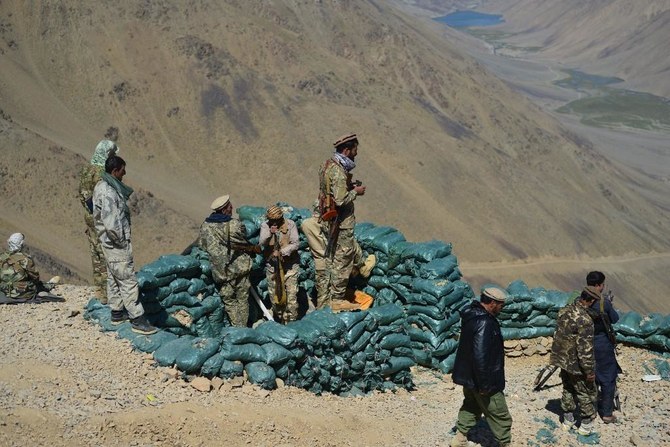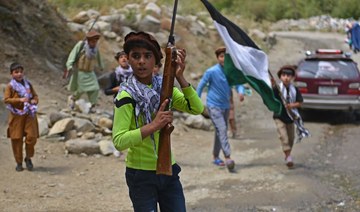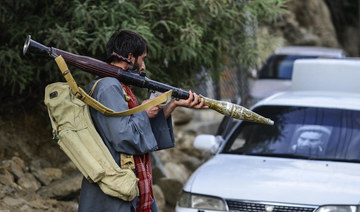PANJSHIR VALLEY, Afghanistan: Atop a craggy mountain that has withstood foreign invaders for decades, anti-Taliban fighters fire a mounted heavy machine gun into a deep valley.
They are members of the National Resistance Front (NRF) — the most prominent Afghan opposition group to emerge since the Taliban captured Kabul nine days ago.
With militia fighters and former government soldiers in its ranks, the NRF has set up machine gun nests, mortars and surveillance posts fortified with sandbags in anticipation of a Taliban assault on their bastion, the Panjshir Valley.
Its fighters, many of them in military camouflage fatigues, patrol the area in US-made Humvees and technicals — pickup trucks with machine guns mounted on the back.
Many carry assault rifles, rocket-propelled grenades and walkie-talkies. Some pose on their vehicles with a dramatic background of snow-covered peaks in the valley, which begins around 80 kilometers north of Kabul.
“We are going to rub their faces in the ground,” said one fighter at a position in the Panjshir heights, listing past victories against the Taliban.
His comrades then raise their fists and chanted “Allah-u Akbar” (God is great).
The strategic valley — populated primarily by ethnic Tajiks — offers natural defense points, with narrow entrances in the shadow of high mountains.
“If Taliban warlords launch an assault, they will of course face staunch resistance from us,” Ahmad Massoud, one of the NRF leaders, said in a Washington Post op-ed last week.
He is the son of the late guerrilla commander Ahmad Shah Massoud, revered for turning the Panjshir Valley into an anti-Soviet and anti-Taliban bastion.
The defensive preparations are familiar for Panjshir residents who saw Massoud thwart multiple Soviet assaults in the 1980s and Taliban attempts to take the area in the late 1990s.
An NRF spokesman said on the weekend that it is ready to resist any Taliban aggression but wants to negotiate with the Islamists about an inclusive government.
The Taliban have also said they want to handle the situation peacefully, but they have bared their teeth by sending hundreds of fighters to the area.
Panjshir was surrounded from three sides, Taliban spokesman Zabihullah Mujahid said Monday.
Former vice president Amrullah Saleh, who headed to the valley after the fall of Kabul, said a humanitarian disaster was brewing.
“Talibs aren’t allowing food & fuel to get into Andarab valley,” he tweeted, referring to an area under Taliban control that abuts Panjshir from the northwest.
“Thousands of women & children have fled to mountains.”
There have been scattered reports of clashes around Panjshir in recent days, with conflicting claims from both sides that have been impossible to independently verify.
The NRF has said it is ready for battle, but it remains unclear if the force has the supplies and equipment to withstand a long siege by the Taliban.
Ahmad Massoud said in his op-ed that they have arms and ammunition stores, as well as the weapons brought to Panjshir by former Afghan forces.
But he added that without help from the outside world, his fighters would not be able to withstand the Taliban’s siege for long.
“We know that our military forces and logistics will not be sufficient,” he wrote.
“They will be rapidly depleted unless our friends in the West can find a way to supply us without delay.”
Elders from the Panjshir Valley have reportedly been speaking with Taliban officials in the Afghan capital, but there has been no breakthrough yet.
Panjshir resistance digs in to defend key valley from Taliban
https://arab.news/p8pz2
Panjshir resistance digs in to defend key valley from Taliban

- National Resistance Front has set up machine gun nests, mortars and surveillance posts fortified with sandbags
- ‘If Taliban warlords launch an assault, they will of course face staunch resistance from us’
South Korea to suspend military pact with North over trash balloons

- Suspending the agreement will pave the way for the South to conduct training near the military border
- The pact had been all but scrapped when Pyongyang declared last year it was no longer bound by it
North Korea has launched hundreds balloons carried by wind across the border that dropped trash throughout South Korea, which called it a provocation and rejected Pyongyang’s claim it was done to inconvenience its neighbor.
The National Security Council said it would raise the plan to suspend the entirety of the military agreement for approval by the cabinet at a meeting on Tuesday.
Suspending the agreement will pave the way for the South to conduct training near the military border and take “sufficient and immediate measures” in response to North Korea’s provocation, the Council said in a statement.
It did not elaborate what those measures may be.
The pact, which was the most substantive deal to come out months of historic summit meetings between the two Koreas in 2018, had been all but scrapped when Pyongyang declared last year it was no longer bound by it.
Since then, the North deployed troops and weapons at guard posts near the military border.
By continuing to comply with the pact, “there have been considerable problems in our military’s readiness posture,” the Council said.
South Korea has previously said it would take “unendurable” measures against North Korea for sending the trash balloons over the border, which could include blaring propaganda from loudspeakers positioned at the border directed at the North.
North Korea has said the balloons were in retaliation for a propaganda campaign by North Korean defectors and activists in the South, who regularly send inflatables containing anti-Pyongyang leaflets with food, medicine, money and USB sticks loaded with K-pop music videos and dramas across the border.
North Korea has reacted angrily to the campaign because it is worried about the potential impact of the materials on the psychology of the people who read or listen to them and on the state’s control of the public, experts said.
Tens of thousands of children in Afghanistan are affected by ongoing flash floods, UNICEF says

- Afghanistan ranks 15th out of 163 nations in the Children’s Climate Risk Index
ISLAMABAD: Tens of thousands of children in Afghanistan remain affected by ongoing flash floods, especially in the north and west, the UN children’s agency said Monday.
Unusually heavy seasonal rains have been wreaking havoc on multiple parts of the country, killing hundreds of people and destroying property and crops. The UN food agency has warned that many survivors are unable to make a living.
UNICEF, the UN children’s agency, said the extreme weather has all of the hallmarks of an intensifying climate crisis, with some of the affected areas having experienced drought last year.
The World Food Program said the exceptionally heavy rains in Afghanistan killed more than 300 people and destroyed thousands of houses in May, mostly in the northern province of Baghlan. Survivors have been left with no homes, no land, and no source of livelihood, WFP said.
UNICEF said in a statement Monday that tens of thousands of children remain affected by ongoing floods.
“The international community must redouble efforts and investments to support communities to alleviate and adapt to the impact of climate change on children,” said Dr. Tajudeen Oyewale, the UNICEF representative in Afghanistan.
At the same time, “UNICEF and the humanitarian community must prepare ourselves for a new reality of climate-related disasters,” Oyewale said.
Afghanistan ranks 15th out of 163 nations in the Children’s Climate Risk Index. This means that not only are climate and environmental shocks and stresses prominent in the country, but children are particularly vulnerable to their effects compared with elsewhere in the world.
Last week, the private group Save the Children said about 6.5 million children in Afghanistan are forecast to experience crisis levels of hunger in 2024.
Nearly three out of 10 Afghan children will face crisis or emergency levels of hunger this year as the country feels the immediate impact of floods, the long-term effects of drought, and the return of Afghans from neighboring Pakistan and Iran, the group said in a report.
More than 557,000 Afghans have returned from Pakistan since September 2023, after Pakistan began cracking down on foreigners it alleges are in the country illegally, including 1.7 million Afghans.
Sheinbaum elected Mexico’s first woman president by landslide

MEXICO: Claudia Sheinbaum was elected Mexico’s first woman president by a landslide Sunday, preliminary official results showed, making history in a country long plagued by gender-based violence.
The ruling party candidate won around 58-60 percent of votes, more than 30 percentage points ahead of her main opposition rival Xochitl Galvez, the National Electoral Institute announced after a quick count.
South Africa’s Ramaphosa says violence has no place after election

- Voters angry at joblessness, inequality and rolling power blackouts slashed support for the ANC to 40.2 percent
JOHANNESBURG: South African President Cyril Ramaphosa said on Monday there was no place for threats of violence or instability after last week’s election cost his African National Congress (ANC) party its majority for the first time.
The result, announced on Sunday, was the worst election showing for the ANC, Africa’s oldest liberation movement, once led by Nelson Mandela, since it came to power 30 years ago, ending white minority rule.
Voters angry at joblessness, inequality and rolling power blackouts slashed support for the ANC to 40.2 percent, down from 57.5 percent in the previous 2019 parliamentary vote.
The result means the ANC must share power, probably with a major political rival, to keep it — an unprecedented prospect in South Africa’s post-apartheid history.
“This moment in our country calls for responsible leadership and constructive engagement,” Ramaphosa told the nation in a weekly newsletter. “There can be no place for threats of violence or instability.”
The sharp drop in ANC support has fueled speculation that Ramaphosa’s days might be numbered, either due to the demands of a prospective coalition partner or as a result of an internal leadership challenge.
But so far senior party officials have publicly backed him, and analysts say he has no obvious successor.
Former president Jacob Zuma’s uMkhonto we Sizwe party has said it is considering a court challenge to the election results, despite performing much better than many had expected to come in third with 14.6 percent of the vote.
Analysts have long feared Zuma’s party may stir up trouble if his supporters, who rioted and looted for days when he was arrested for contempt of court in 2021, reject the results.
Ramaphosa added, “South Africans must stand firm against any attempts to undermine the constitutional order ... for which so many struggled and sacrificed.”
Sri Lanka closes schools as floods and mudslides leave 10 dead and 6 others missing

- Six people died after being washed away and drowning in the capital, Colombo, and the remote Rathnapura district on Sunday, according to the disaster management center
COLOMBO: Sri Lanka closed schools on Monday as heavy rain triggered floods and mudslides in many parts of the island nation, leaving at least 10 people dead and six others missing, officials said.
The education ministry announced that the reopening of schools would depend on how the weather develops.
Heavy downpours have wreaked havoc in many parts of the country since Sunday, flooding homes, fields and roads, and forcing authorities to cut electricity as a precaution.
Six people died after being washed away and drowning in the capital, Colombo, and the remote Rathnapura district on Sunday, according to the disaster management center. Three others died when mounds of earth collapsed on their houses, and one person died when a tree fell on him. Six people have gone missing since Sunday.
By Monday, over 5,000 people had been moved to evacuation centers and more than 400 homes had been damaged, the center said in a statement.
Navy and army troops have been deployed to rescue victims and provide food and other essentials to those affected.
Sri Lanka has been grappling with severe weather conditions since mid-May caused by heavy monsoon rains. Earlier, strong winds downed trees in many areas, killing nine people.














